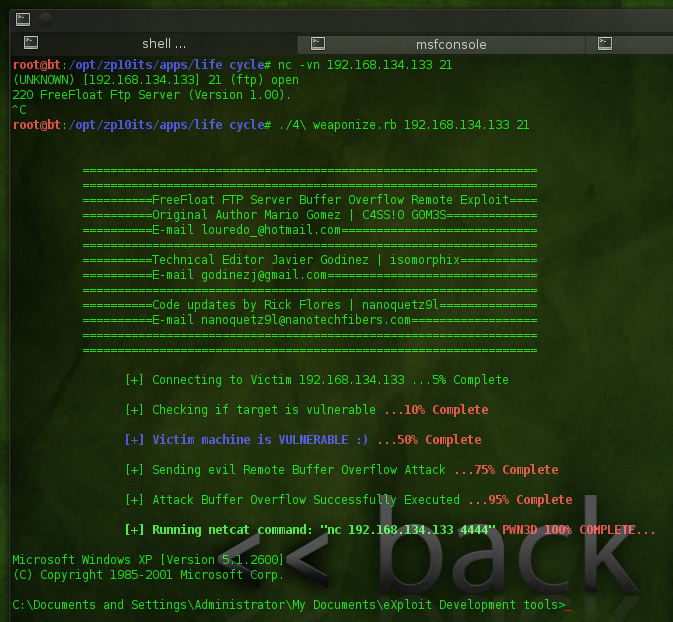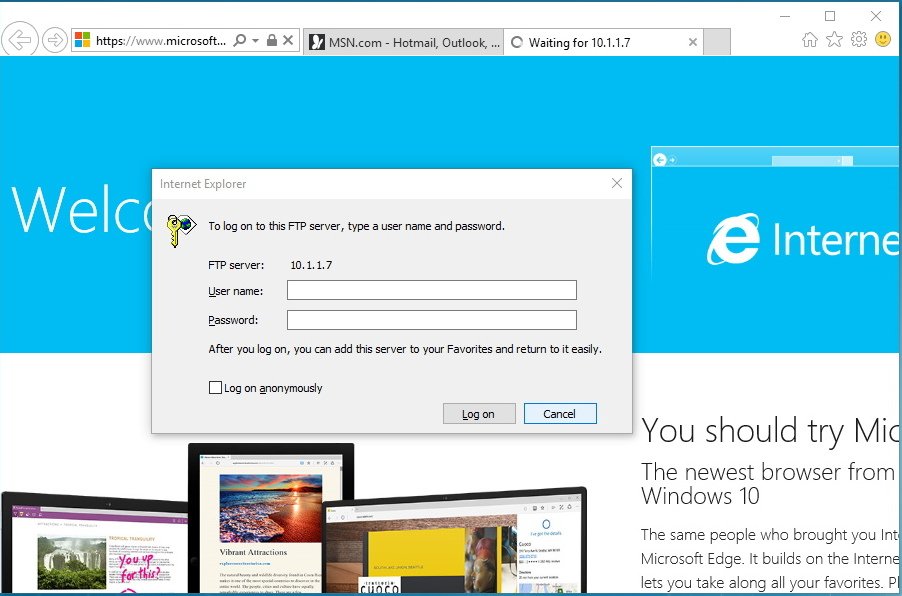Severity: High
8 February, 2011
Summary:
- This vulnerability affects: The IIS FTP service running on Windows Vista, 2008, 7, and 2008 R2
- How an attacker exploits it: By sending a specially crafted FTP command
- Impact: In the worst case, an attacker gains complete control of your IIS server
- What to do: Deploy the appropriate IIS update immediately, or let Windows Automatic Update do it for you
‘An exploit code for Microsoft’s FTP Server vulnerability has been released. This exploit code can be used to test your system against the mentioned attack.’ Credit: ‘The information has been provided by Critical Watch Bugtraqqer.’. The Exploit Database is a CVE compliant archive of public exploits and corresponding vulnerable software, developed for use by penetration testers and vulnerability researchers. Our aim is to serve the most comprehensive collection of exploits gathered through direct submissions, mailing lists, as well as other public sources, and present them in a freely-available and easy-to-navigate database.
Sep 15, 2017 FTP Server: ubuntu. Attacker system: Kali Linux. Client system: window. FTP Installation. Vsftpd stand for Very secure FTP daemon is an FTP server for Unix-like systems, including Linux. Let’s start by typing following command to install vsftpd for FTP service. Apt-get install vsftpd. This will start FTP service on port 21. Microsoft FTP Service 7.0 and 7.5 for Internet Information Services (IIS) processes unspecified commands before TLS is enabled for a session, which allows remote attackers to obtain sensitive information by reading the replies to these commands, aka.
Exposure:

Internet Information Services (IIS) is the popular web and ftp server that ships with all server versions of Windows.
In a security bulletin released today as part of Patch Day, Microsoft describes a serious vulnerability that affects the optional FTP server that comes with the latest versions of IIS. Specifically, the IIS FTP service suffers from a buffer overflow vulnerability involving the way it handles a specially crafted FTP commands (or more specifically, specially encoded characters in an FTP response). By sending such a malformed FTP command, an attacker could exploit this vulnerability to either put your FTP server into a Denial of Service (DoS) state, or to gain complete control of it. An attacker does not have to authenticate to your FTP server to launch this attack.
However, IIS does not install or start the IIS FTP service by default. You are only vulnerable to this attack if you have specifically installed and started this service. That said, many administrators do enable IIS’s FTP service in order to give web administrators an easy way to update their web sites. If you are one of those administrators, you should consider this flaw a serious risk.
Researchers have already publicly released Proof-of-Concept (PoC) exploit code demonstrating the DoS version of this flaw. Whether or not you are using the IIS FTP service, we still recommend you download, test and install this update as soon as you can. Being a critical server update, we highly recommend you test it on non-production servers before pushing it to your real web site.
Solution Path:
Download, test, and deploy the appropriate IIS patches immediately, or let Windows Automatic Update do it for you.
- For Windows Vista (w/SP1 or SP2)
- For Windows Vista x64 (w/SP1 or SP2)
- For Windows Server 2008 (w/SP2)
- For Windows Server 2008 x64 (w/SP2)
- For Windows 7
- For Windows 7 x64
- For Windows Server R2 2008 x64
- For Windows Server R2 2008 Itanium
For All WatchGuard Users:
This attack leverages seemingly normal FTP response traffic. You should apply the updates above.
Status:
Microsoft has released patches to fix this vulnerability
References:
This alert was researched and written by Corey Nachreiner, CISSP.
What did you think of this alert? Let us know at [email protected].
More alerts and articles: Log into the LiveSecurity Archive.
Related Posts
Severity: High 8 February, 2011 Summary: This vulnerability affects: The IIS FTP service running on Windows Vista, 2008, 7, and 2008 R2 How an attacker exploits it: By sending a specially crafted FTP command Impact: In the worst case, an attacker gains complete control of your IIS server What to do: Deploy the appropriate IIS [].
The best posible result is TERE BINA TERE BINA DIL NAHI LAGDA BY RAHAT FATHE ALI KHAN that has been uploaded by AZ5JUTT786 and Tere Bina Song| Tezz| Ajay Devgan & Kangna Ranaut| Rahat Fateh Ali Khan probably the last item we have been found. You can download best quality Tere Bina Dil Nahi Lagda mp3 incuding 320kbps. Tere Bina Song| Tezz| Ajay Devgan & Kangna Ranaut| Rahat Fateh Ali Khan - mp3 by VENUS MOVIES Bitrate 128kbps|| Frequency 44100 Hz You are searching for Tere Bina Dil Nahi Lagda mp3 songs download. We have found total 14 songs. Soniye dil nahi lagda tere bina female mp3 download. Tere Bina Dil Nahi Lagda free mp3 download, Tere Bina Dil Nahi Lagda free mp3 download 320kbps, Tere Bina Dil Nahi Lagda free mp3 download mp3lio, Tere Bina Dil Nahi Lagda song download mp3, Tere Bina Dil Nahi Lagda mp3 song free download, Tere Bina Dil Nahi Lagda audio download, Tere Bina Dil Nahi Lagda mp3 download skull,Tere Bina Dil Nahi Lagda free mp3 download lyrics.
FTP is a service that is commonly used in Web Servers from Webmasters for accessing the files remotely.So it is almost impossible not to find this service in one of our clients systems during an engagement.
For that reason we will try to cover in this article a scenario of a possible attack against the FTP Server.
The first thing that we need to do is of course to identify which systems are running the FTP service (for the needs of this tutorial I have put only one system). We can do a simple scan with Nmap in order to find the open ports.
We can see that the FTP port is open. Now the next logical step that we have to do is to identify which version the FTP application is running by using a method which called FTP banner grabbing.
Of course we can use the Nmap for the discovery of the remote operating system and the service fingerprinting but in this tutorial we will not take advantage of that.
Banner Grabbing is a technique that someone can use in order to extract information from application banners.For example if the remote host is a web server,we can try to connect through telnet.The banner results will give us an indication about the operating system and the type of the web server (Apache or IIS).
Command: telnet target_IP 80
In order to do a banner grabbing in the FTP service we will just try to connect through our console to the FTP server.
FTP Banner Grabbing
From the above image we can see that the version is 1.3.1 and the operating system is Debian.There are many things that we can do from here.First we can try to find if there is any public exploit for the ProFTPD 1.3.1 version.If there is then we can launch it against the FTP Service.
If there is not any public exploit for the specific version then we can try to find a valid username and password by using a dictionary attack.We can use any tool like THC Hydra for this job but in this article we will see how it could be achieved through metasploit.
Metasploit Framework has a specific module for attacking FTP servers.So we will search on the metasploit for the module ftp_login.

Now that we have found the FTP scanner it is time to configure it.Of course we will need some good wordlists for the usernames and the passwords.If we don’t have then there is no problem because metasploit has a folder with various wordlists.Here we will use the wordlists that contains Unix usernames and passwords.
We are setting the scanner according to the following image and we type run in order to the scanner to start:
FTP Scanner Settings
The scanner has discovered 3 valid login credentials as you can see from the next 3 images.
Discovery of the service username/password
So now we have three valid logins to choose in order to connect to the FTP server.Lets try the last one which is the user as username and user as password.
Login with a valid account on the FTP server
We can see that we have successfully managed to login to the FTP server.Now we can execute the command ls -lat to the server in order to display the list with the current directories and subdirectories and the permissions that we have on the directories.
There are two directories that are important here.The SSH because it may contain private SSH keys and the bash_history because it keeps a history of all the commands that the user has run.For example you can find information about user ID,passwords,confidential file names,locations,server names and shared folders.
We will download the bash_history file to our computer with the command get as you see it in the image below:
Download the file to our computer
Except of the console for the connection to the FTP server we can use also our browser.We will try to login with the same credentials user/user
After some searching in the directories we have found a directory which contained the following:
Directory of usernames
We can see that there are 4 folders.A folder named user, a folder named service and a folder named msfadmin.
Microsoft Ftp Service
220 Microsoft Ftp Service Exploit Metasploit
This is an indication that another account exists under the username msfadmin which probably is an administrator’s account and has more privileges.The reason that we assumed that is because the folders names are the same with the usernames that we have discovered previously.
The previous accounts had passwords same with the usernames.So we will try to login with the following credentials:
Username: msfadmin
Password: msfadmin
The image above is showing that our try to login with the username/password msfadmin was successful.If the password was different then we could have tried another dictionary attack against the FTP server in order to find and the password.

So we have managed to login to the FTP server with an administrator’s account.
Conclusions
There are some conclusions that we can make regarding this scenario.First of all the banner grabbing allow us to discover valuable information about the FTP server and the target operating system.This means that if the administrator had changed the FTP banner then it would be much harder for us to disclose these information.
In addition we have noticed the weak credentials of the 3 accounts that we discovered.Also the administrator’s account password is the same with the username.This account policy is unacceptable in most of the companies and probably you will not meet something similar.However even large organizations are suffering from weak passwords so eventually it can happen.It is important for that reason to have a good password policy.

220 Microsoft Ftp Service
On the other hand if a malicious user was trying brute force or dictionary attacks (like this scenario) against the FTP server then it would probably flooded the log files.A security solution that would block the IP address after 3 unsuccessful logins would be the most effective.
Microsoft Ftp Service 5.0 Exploit
Microsoft Ftp Site

